Last Updated on January 22, 2023
Dragons are undoubtedly the most iconic monster in all of Dungeons & Dragons. They’re one-half of the name of the game, for starters. In the real world, our cultures, mythologies, and even apocryphal histories are rich with mention of dragons.
In the east, dragons are ancient, wise, and powerful; often bound up in the teachings of Buddhism, Confucianism, and Taoism, dragons have long been revered as sources of power and bringers of rain.
In the west, dragons are the fire-breathing nightmares that once haunted the edges of our maps, kidnappers of princesses, and the ultimate test of a hero’s courage.

Across the many multiversal worlds of D&D, dragons are a constant threat.
Though dragons – especially those who have lived to see many ages of the lesser races come to pass – can be friends (staunch allies, even) of humanoid races, more often they are seen as death upon the wing, a four-legged apocalypse capable of crushing entire kingdoms beneath its razor-sharp claws.
It would be unfair, however, to tar all dragons with the same brush. Beyond the three great noble taxonomic families – chromatic, metallic, and gem – there are myriad varieties of draconic creatures, from the corrupted Shadow Dragon to the venerable Dragon Turtle.
With the launch of the new Fizban’s Treasury of Dragons sourcebook, we’re going to be doing a series of deep dives into D&D’s most iconic, most fearsome monster, starting with the two quintessential varieties: the chromatic dragons and metallic dragons – as well as the two draconic deities they often worship, the noble Bahamut and the dread Tiamat.
Dragon Ages
All true or noble dragons pass through four distinct stages of life, from lowly wyrmlings to ancient dragons, the oldest of which can live for more than a millennium.
As dragons age, their minds (as well as their increasingly formidable physical bodies) grow. A dragon wyrmling may have the personality and intelligence of your average housecat – a truly terrifying concept given the hell raised on a daily basis by the small furry shadow dragon that rules my life.

As they grow, between six and a hundred years, dragons may have the impetuosity and emotional range of a teenager (even more troubling than an acid-spitting house cat), which can mellow significantly over the subsequent centuries, depending on the type of dragon.
White Dragons, for example, almost always remain bestial, stupid, and vicious, whereas a Brass Dragon who reaches adulthood has typically evolved into a highly intelligent being with a solid grasp on morality and a fondness for humans (the opposite of a cat, then).
Ancient dragons possess not only the ability to raze entire cities to the ground but the wisdom and arcane knowledge of the ages – such knowledge that would turn even the most venerable elven sage green around the gills.
Dragon Age Categories
| Category | Size | Age Range |
| Wyrmling | Medium | 5 years or less |
| Young | Large | 6–100 years |
| Adult | Huge | 101–800 years |
| Ancient | Gargantuan | 801 years or more |
Draconic Magic
As all dragons grow, the innate magic that flows in their veins begins to manifest itself as a natural talent for spellcasting – although some dragons may take a more traditional route, seeking out powerful mages to teach them their secrets.
Using these variant rules (which I wholly recommend as a DM who likes to run dragons as more than just a big bag of hit points with a breath weapon), a young or older dragon can innately cast a number of spells equal to its Charisma modifier.
Each spell can be cast once per day, requiring no material components, and the spell’s level can be no higher than one-third the dragon’s challenge rating (rounded down).
The dragon’s bonus to hit with spell attacks is equal to its proficiency bonus + its Charisma bonus. The dragon’s spell save DC equals 8 + its proficiency bonus + its Charisma modifier.
Personally… I like to pick spells that make sense for the dragon’s type, and reflavor them to be semi-physiological effects, rather than have dragons shouting “Fireball, Fireball, Fireball”.
I would give a Green Dragon (defined by its poisonous breath and gift for trickery) access to spells like Ray of Sickness or Charm Person and reflavor them both as the psychotropic effects of its noxious breath.
Fizban’s Treasury also includes some great expanded rules for draconic spellcasting, including the ability for powerful dragons to grant draconic gifts upon lucky adventurers that range from hardened, scaly skin (that grants resistance to bludgeoning, piercing, and slashing damage) to literally changing your character’s race to Dragonborn.
The Noble Dragons
There are three great families of so-called “noble” dragons (at the risk of a Plato x Diogenes featherless biped situation, noble dragons are huge, scaly, innately magical, intelligent lizards with a breath weapon) now that Fizban’s Treasury has introduced gem dragons like the Amethyst and Crystal Dragons.
However, in this article, we’re going to be focusing on the two original families of dragon: metallic (which includes Brass, Bronze, Copper, Gold, and Silver dragons) and chromatic (Black, Blue, Green, Red, and White dragons).
Chromatic Dragons: Cruelty and Greed
Chromatic dragons are probably what leaps to mind when most players and dungeon masters are asked to think of a dragon. They are huge, powerful monsters with giant egos and an insatiable hunger for treasure and charred flesh.
Although there are always exceptions to the rule, chromatic dragons are overwhelmingly evil.
They prey upon those they view as members of “lesser” races, burn towns and cities to the ground, and amass huge hoards of treasure, either plundered from their smoldering victims or presented as offerings by cowering servants – typically “evil” creatures like hobgoblins or kobolds who serve (or even worship) the dragon in the hope that it, in its infinite mercy, decides to eat them last.

Chromatic dragons worship the demonic Dragon Queen Tiamat – whose five heads resemble the five colors of chromatic dragon. Such dragons are often treated as living extensions of her terrible power by the cults that worship in her name.
Red Dragons
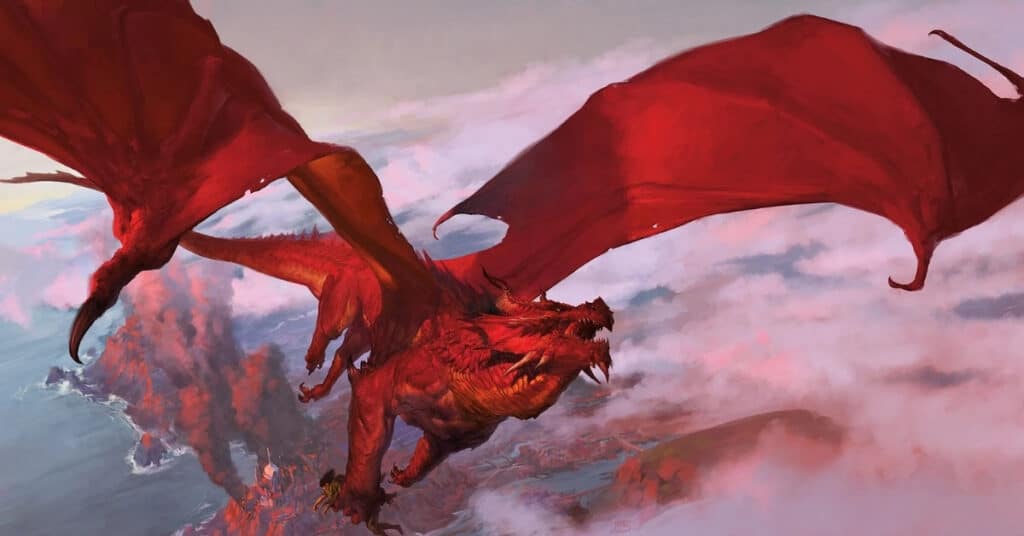
Personality: The most avaristic of the dragons, Red Dragons constantly seek to expand their glittering hoards.
Physical Characteristics: Red Dragons have the largest wings of any chromatic dragon, with a blue-black tint along their trailing edge that resembles metal scorched by fire. Their scales range from bright crimson to the dark red of a dying fire. Their profile is defined by swept-back horns and a frilly spine, their nostrils perpetually leak thick black smoke, and their eyes flash with fire when angered.
Environment: Fiercely territorial, Red Dragons favor arid, desolate badlands and mountainous terrain with plenty of high vantage points from which they can survey the world around them.
Attacks: In addition to the usual mixture of claw and bite attacks, Red Dragons can belch forth a torrent of raging fire, smash enemies with their tails, or knock down every nearby foe with a flap of its powerful wings. Older Red Dragons are nightmarish to behold, and as such can terrify even the most stalwart dragonslayer with their Frightening Presence.
Lair Actions: Red Dragons often make their lairs in areas with high levels of geothermal activity, which is further intensified by their presence. The dragon can call forth gouts of lava and volcanic gas, or cause the very ground to break apart with a stamp of its clawed foot, sending prospective thieves (and probably a few of its servants, too) tumbling to a fiery doom.
Red Dragons are impulsive and arrogant, prone to flying (pardon the pun) into destructive rages that can level entire empires in response to the smallest of slights.
Their covetous nature means a Red Dragon knows the identity and location of every piece of treasure in its horde, and the theft of even the smallest gold coin (or magic ring, ahem, Bilbo, cough cough) can lead to the total destruction of every town within a hundred leagues.
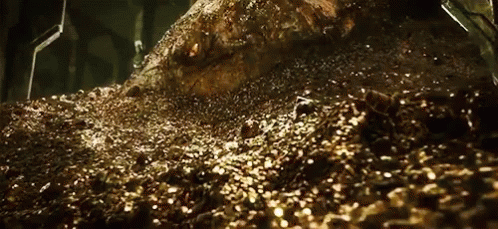
They make their lairs in deep mountain caves, or even the mouths of active volcanoes, and often surround themselves with cowering servants to do their bidding and fawn over them – until the dragon becomes hungry, that is.
Black Dragons

Personality: Evil-tempered and cruel, even for chromatic dragons, Black Dragons loathe the success of the “lesser races”, and often conspire to bring humanoid kingdoms to ruin before nesting among the crumbling detritus of a once-prosperous civilization. Basically, they’re massive dicks.
Physical Characteristics: Scales ranging from glossy black to dull, well-camouflaged charcoal, and shades of slightly darker black. Black Dragons have curving, segmented horns, deep-socketed eyes and broad nasal openings which make their features strongly resemble a skull.
Environment: Black Dragons make their homes in swamps, ruins, and (ideally) swampy ruins.
Attacks: The usual claws, bite, tail, wing, and frightful presence attacks aside, Black Dragons exude a line of corrosive acid from their mouths capable of melting the strongest stones – or the hardiest adventurer – into a puddle of bubbling slag.
Lair Actions: The presence of a Black Dragon turns an already unpleasant swamp into a nightmarish morass of biting insects, impassable mudflats, and magical darkness, which the dragon can command to disorient and wear down its foes.
If you ever find yourself in a Black Dragon’s lair, just run. These are easily the most brutal and cruel of all the true dragons, and take great pleasure in witnessing (or directly causing) the failure of humanoid civilizations.
Black Dragons amass vast hoards of antiquities, grim souvenirs plundered from the many empires they have laid waste to, and it’s common enough to find artefacts of great power among their priceless collections of jewelry and gems.
You smell a Black Dragon’s lair before you see it. Nestled in the foetid heart of its swampy home, the air hangs thick with the stench of rotting vegetation, and the water runs stagnant with the decomposing corpses of its prey, which the dragon keeps half-submerged in brackish fluid to augment the fermentation process.
Blue Dragons
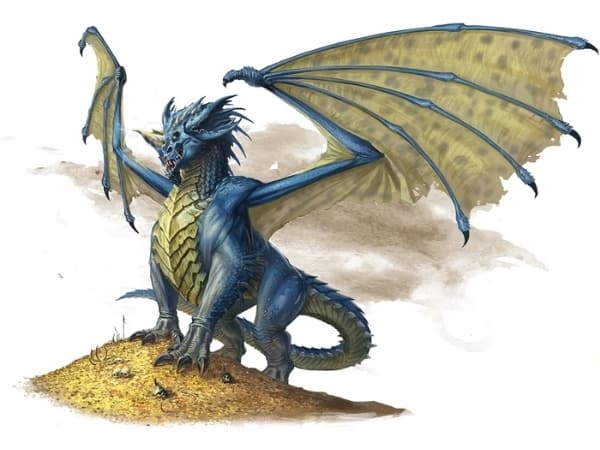
Personality: Vain, territorial, and opportunistic, Blue Dragons will not stand for any remark or insinuation that they are weak or inferior.
Physical Characteristics: Iridescent blue scales that range from bright azure to deepest indigo, polished to a mirror finish by the desert sands. Blue Dragons have dramatically frilled ears, which they can seal completely to block out sand, and a huge, jagged horn which helps them burrow through the dunes.
Environment: Desert dwellers, Blue Dragons are opportunistic hunters that prey upon nomads and merchant caravans, using their flight and lightning breath to patiently pick off their foes one by one.
Attacks: The Blue Dragon is wreathed in a cloak of crackling static electricity, which it can concentrate in its jaws to unleash a searing line of raw lightning.
Lair Actions: The Blue Dragon’s lair is made of excavated sand, sometimes partially turned to crystal or glass by its lightning breath. When threatened, the Blue Dragon can collapse part or all of its lair, burning its enemies alive – if they ever get close that is, for the Blue Dragon’s presence surrounds its lair in miles upon miles of raging thunderstorms.
The rasp of sand against scales creates a corona of static electricity around the Blue Dragon, which it can coalesce into powerful lightning attacks. It also uses its electric breath to crystalize sand into glass, sculpting a vast subterranean lair for itself, from which it flies across the desert to more verdant lands in search of prey.
Definitely my favorite dragon in D&D 5e, the Blue Dragon is an elemental force, raising thunderstorms and raging sands to swallow entire merchant caravans whole, after which it descends from the endless blue sky to feast.
Blue Dragons can also be found in dry steppes and along rocky coasts, but they are most at home in the deep desert, where they surround their lairs with all manner of vile beasts like giant scorpions, dust devils, and ankhegs.
Especially powerful Blue Dragons covet the servitude of other powerful creatures, like bards, wizards, or even genies – viewing their subservience as a monument to their vanity.
Green Dragons
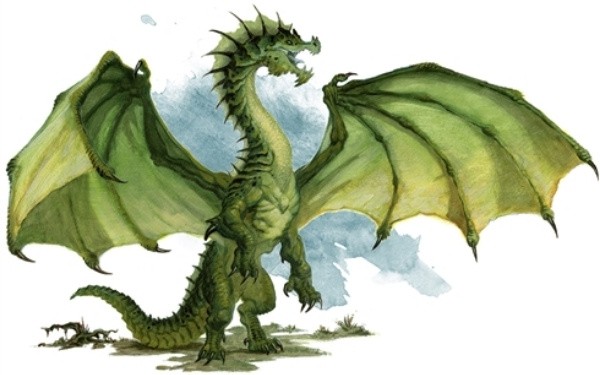
Personality: Cunning, treacherous, and thirsty for both power and gold in equal measure.
Physical Characteristics: Green Dragons start out in life the color of emeralds and new leaves, but darken over the centuries until they are virtually indistinguishable from the forests they call home. They also have the longest legs and necks of any dragon, allowing them to move unhindered through thick undergrowth and scan their surroundings with ease.
Environment: Green Dragons make their homes in deep forest, which grows more wild – choked with thorny vegetation and sickly yellow fog – with their continued presence.
Attacks: Clouds of poisonous fumes belch forth from the Green Dragon’s mouth, searing the lungs and addling the mind.
Lair Actions: The Green Dragon’s lair of choice is a cave or grotto at the heart of a deep forest, which it surrounds with a labyrinth of razor-sharp thorns and vines. These vines can spring to life at the dragon’s command, ensnaring intruders for the monster to devour at its leisure.
Green Dragons are the most manipulative and two-faced of all dragons. Their lust for treasure is matched – even eclipsed in some cases – by their craving for power over other races (and other dragons).
As such, Green Dragons are schemers, tricksters, often plotting the corruption of nearby civilizations. They’ll pour honeyed works into the ears of the weak or foolish, turning them against their friends and loved ones – pawns in a cruel, inhuman game.
One of my favorite campaigns of all time started with a Green Dragon enslaving the mind of an elven king, who sent forth his armies to wage all out war upon the unsuspecting human kingdom at the forest’s edge.
The players only figured out what was actually going on when it was noticed that the elves (who had no love for the precious metals of the manlings) were making off with all the gold, silver, and platinum they could carry.
White Dragons
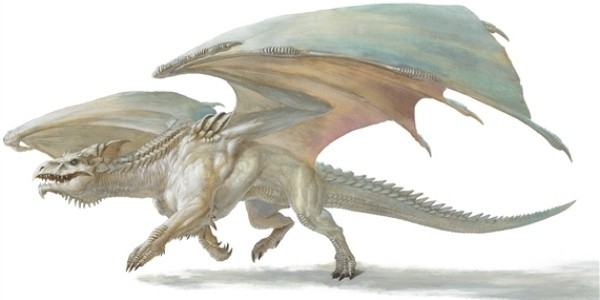
Personality: Bestial, vicious, and greedy, White Dragons are the most animalistic of the dragons, and live for the thrill of the hunt and the pleasure of the kill.
Physical Characteristics: The smallest of the dragons (for what it’s worth), White Dragons blend into their arctic habitats with the subtlety of a polar bear, bursting from the snow with frilly spines erect and eyes filled with feral hatred. Over time, their pure white sheen fades to mottled blues and grays, like an iceberg beneath the arctic sea.
Environment: White Dragons are the alpha predator of snowy tundra, ice-capped mountains, and deep, frozen ice fields.
Attacks: White Dragons can emit a torrent of roiling frost and ice, freezing their enemies’ corpses to be defrosted later in the tepid stew of their stomach juices.
Lair Actions: Older White Dragons can command the winter snows themselves, and those who set foot in their lairs find themselves assaulted by bitter winds, surrounded by vortexes of frozen sleet, and crushed beneath tumbling blocks of ice.
White Dragons are often underestimated. Smaller, more stupid, and even less fond of company than other chromatic dragons, the White Dragon is closer to a beast than any of its kin.
However, in addition to being perfectly adapted to its hostile environment, the White Dragon possesses an incredible memory, holding grudges that can last for centuries as it grows in size and plots its revenge.
White Dragons love ice (surprise, surprise), and therefore prize treasure that resembles it, like diamonds, although they will also hoard walrus tusks, figureheads from ships, furs, and the frozen corpses of powerful enemies the dragon has slain – which it leaves dotted around the mouth of its lair as a warning to anyone foolish enough to step inside.
Metallic Dragons: Knowledge, Wisdom, and Power
Unlike their chromatic cousins, metallic dragons tend towards the good (or neutral) end of the alignment chart.
While they can still be prone to arrogance or fits of pique (often with horrible consequences) their personalities skew more towards curiosity and they often take genuine delight in interacting with humanoid races.
They often do this through their ability to shapeshift into more innocuous forms, traveling the lands, interacting with humanoids, and acting as everything from magical pranksters to something more like a guardian angel (honestly, if I had to choose a divine being to have in my corner, I’m afraid I’d have to ask those weeny celestials to go and sit back down).
Some metallic dragons strike up multi-generational friendships with a single humanoid family, and others may even serve as staunch allies in the war against evil – especially when worshippers of the demonic Dragon Queen Tiamat are involved.
Metallic dragons tend to worship the minor god Bahamut, the platinum dragon who either dwells on the celestial plane or wanders the world disguised as a kindly sage accompanied by seven golden canaries – which are secretly seven ancient gold dragons in disguise, and a potent reminder to murderhobo players not to pick on random old men who collect exotic birds.
Brass Dragons
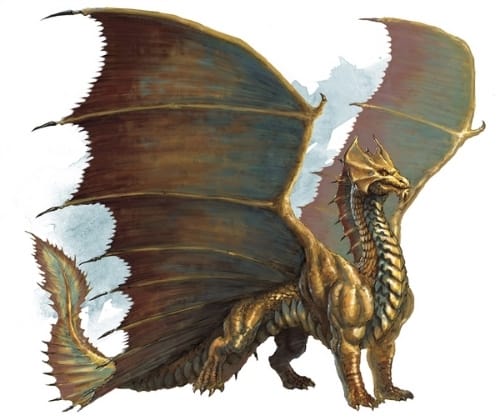
Personality: Gregarious and keen conversationalists fond of philosophical discourse and filthy jokes in equal measure.
Physical Characteristics: A Brass Dragon’s face is framed by a thick ridge of bone, and a row of frilly spines trailing down the length of its neck. Their scales change over time from mottled brown to lustrous, burnished brass.
Environment: Brass Dragons are most at home in dry, sunny climates.
Attacks: In addition to its physical attacks and fiery breath, a Brass Dragon can also exhale a cloud of sleeping gas.
Lair Actions: A Brass Dragon can conjure up gusts of wind and torrents of swirling sand to obscure it from an enemy’s view. It also fills the area surrounding its lair with illusory monsters to deter intruders and lays false paths that double back from its lair and arrive at nearby water sources.
Brass dragons, above all else, love conversation. Even the treasure most prized by Brass Dragons is that which provides them with opportunities for conversation, like talking swords or magic lamps with genies inside.
If Brass Dragons have one weakness it’s that they are overly trusting of anyone who genuinely enjoys a good conversation, and may be blinded to an otherwise untrustworthy individual who just happens to love talking to it.
They tend to be smart enough to recognize attempts at manipulation, however, but are more likely to throw themselves into a battle of deception than resort to a blast of fire.
Bronze Dragons
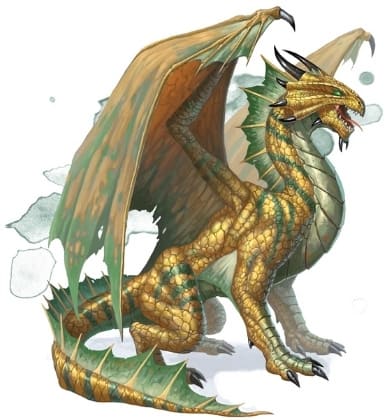
Personality: Curious and brave, Bronze Dragons enjoy watching humanoids go about their business – usually hidden in polymorphed form – but feel honor bound to intervene if they witness evil
Physical Characteristics: Bronze Dragons are distinguished by a ribbed and fluted crest atop their heads, as well as their webbed feet and greenish-tinged wingtips. As the dragon ages, its pupils fade away, leaving its eyes two glowing green orbs.
Environment: Bronze Dragons favor coastal environments, and are just as home in the water as they are on land or in the air.
Attacks: In addition to their physical armaments and lightning breath weapon, Bronze Dragons have a non-lethal (ok, less lethal) repulsion breath which can hurl enemies or unwanted enemies away from it at speed.
Lair Actions: Bronze Dragons make their lairs in coastal caves, sometimes nesting in the wreck of a ship it has painstaking recovered from the sea. It exerts almost total control over the weather in the surrounding area, and is capable of subjecting uninvited guests to a peal of deafening thunder at painfully close quarters.
Bronze Dragons are both curious and fearsome. Typically, they enjoy leaving their coastal lairs to disguise themselves as dolphins or albatross to swim or fly alongside fishing boats, observing the sailors at work.
If a Bronze Dragon sees a ship laden with cargo that it desires, it might suddenly revert to its true form and bargain with the (presumably now terrified) captain for some of the treasure.
Bronze Dragons are also brave, with a keen eye for injustice. Sometimes, when evil (especially worshippers of Tiamat) rears its ugly head, Bronze Dragons will forsake their detached neutrality to join up with the side it perceives to be in the right, and makes for a staunch and powerful ally in battle.
Copper Dragons
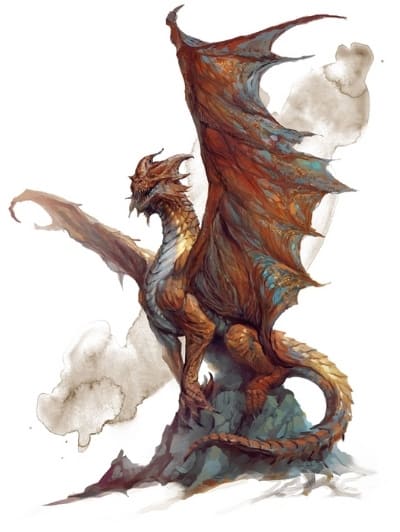
Personality: Playful pranksters, jokesters and riddle-lovers, Copper Dragons are some of the most gregarious and even-tempered of all dragons – although their tendency to covet gold can bring out a decidedly mean streak.
Physical Characteristics: A Copper Dragon’s segmented horns and backwards sweeping cheek frills give it a pensive, quizzical look. Their become increasingly oxidized over the centuries, with Ancient Copper Dragons being almost completely green with glowing turquoise eyes.
Environment: Copper Dragons make their homes in rocky uplands and hilly areas, dwelling in naturally occurring caves with sandy floors and many false walls behind which it can hide its treasure.
Attacks: In addition to its claws, bite, tail, wings, and corrosive acid breath, Copper Dragons can emit a wave of soporific gas, which reduces its enemies’ movement and attacks per turn.
Lair Actions: Within its lair, a Copper Dragon can turn solid earth into cloying, impassable mud, or cause stone spikes to burst from the ground.
If a Copper Dragon ever tells you a joke, you’d better laugh. Although incorrigible pranksters and some of the friendliest dragons in D&D, Copper Dragons also possess relatively thin skin and a fondness for treasure that may supersede their naturally gregarious temperament.
Copper Dragons are especially fond of bards, and some even permanently install one in a luxurious corner of their lair; the dragon considers the bard’s company treasure enough.
The doesn’t mean that a Copper Dragon won’t fight to the death to defend its hoard, and one won’t part with something in its collection lightly. It is still a dragon, after all.
Gold Dragons

Personality: Gruff, sagacious, and wholly devoted to the eradication of evil, Gold Dragons are not as warm or friendly as their Copper, Bronze, and Brass cousins, though they are fiercely loyal to those they deem to be friends.
Physical Characteristics: Clad in shimmering golden scales, a Gold Dragon’s sail-like winds run along the full length of its body, which gives it the impression of a fish swimming throughout the air. They have especially wise faces, with frills that give the appearance of whiskers. They are the largest and most powerful of the metallic dragons. Their eyes resemble pools of molten gold.
Environment: Gold Dragons forgo the traditionally dank cave for isolated, idyllic places far removed from prying eyes. Some make their homes on mist-shrouded islands, or behind sparkling waterfalls.
Attacks: In addition to its fiery breath, a Gold Dragon can also spew forth a wave of gas which weakens its enemies, rendering them unable to fight.
Lair Actions: Within its lair, the magic of a Gold Dragon is strongest, allowing them to glimpse the future, warp the minds of those who enter uninvited, and visit nearby travelers in their dreams.
Gold Dragons are the most magical of all true dragons and are as attuned to the subtle magic of dreams and enchantment as they are often disinterested in the outside world.
While a few Gold Dragons still travel the wider world in disguise, they rarely reveal their true forms, and rarely even converse with other dragons – let alone humanoids.
Gold Dragons are also unique in that they are the only sort of dragon that will eat their own hoard. Gold Dragons can eat virtually anything, but particularly enjoy a diet of pearls and gems.
Silver Dragons
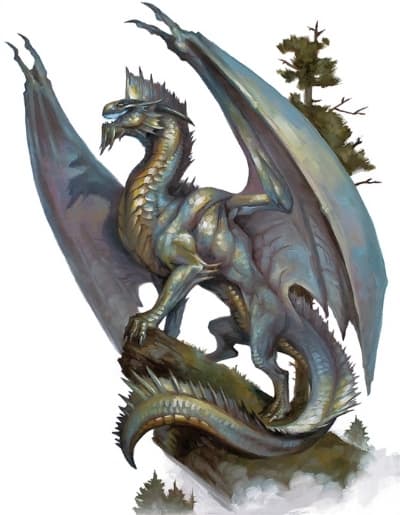
Personality: The most friendly and fond of humanoids of any draconic species, Silver Dragons are also one of the few dragon types that enjoys socializing with its own kind, and will cheerfully go out of their way to assist a creature in need.
Physical Characteristics: A Silver Dragon could easily be mistaken for a sculpture. From its eyes – which resemble pools of mercury – to its wingtips, an adult Silver Dragon appears to be made from pure, iridescent metal.
Environment: Silver Dragons dwell at altitude, preferring a life lived among the clouds. They tend to roost on mountaintops – although their fascination with humanoids means that an abandoned wizard’s tower or ancient fort is a prized candidate for a lair.
Attacks: In addition to its claws, teeth, and freezing cold creath weapon, the Silver Dragon has perhaps the most dangerous attack of all the metallic dragons: a paralyzing blast that can incapacitate an entire party in seconds.
Lair Actions: When in its lair, a SIlver Dragon can turn the naturally frigid environment to its advantage, wreathing the area in impenetrable fog or summoning an icy wind that freezes intruders in their tracks.
Of all the metallic dragons, Silver Dragons are the most friendly to humanoids – humans in particular, as they find the shortness of their lives and the resultant urgency and zeal they display to be fascinating.
Silver Dragons love to collect treasure that is not only valuable but steeped in the history of those who made it, prizing the journal of a famous hero just as highly as a chest overflowing with rubies and emeralds.
They love to dwell within the ruins of great humanoid structures and augment such buildings with their ability to shape clouds and fog into substances as solid as stone.
The Dragon Gods: Bahamut and Tiamat
The question of exactly what something as mighty as a dragon might worship as a god is a sobering one. And the answers bring little comfort to the minds of very small, very mortal folk.
By and large, dragons recognize two deities, both of whom supposedly had a hand in creating the world, although they certainly exist in a halfway house between the divine and material.
Most gods don’t walk upon the earth, which puts the dragons’ deities somewhere between gods, monsters, and enlightened prophets. It all feels slightly Buddhist, actually.
Bahamut
The metallic dragons worship Bahamut, the platinum dragon who dwells in the Seven Heavens of Mount Celestia, but often wanders the prime material plane in disguise.
He often appears as an old man, a kindly sage dressed in peasant garb accompanied by seven golden canaries, which are actually ancient Gold Dragons in disguise.
Bahamut isn’t a god on par with some of the other good aligned deities, but some humanoid clerics still worship him as a paragon of justice and protection, and he in turn can grant divine spells to those who worship in his name.
While he may stop on occasion for a friendly chat with travelers on the road (seriously, Bahamut might as well be the patron saint of DMs who are fed up with their party of murderhobos brutally killing and robbing everyone they meet) Bahamut rarely interferes directly in mortal affairs.
He makes an exception, however, when dealing with the machinations of those who follow his dark counterpart: Tiamat, the Queen of Evil Dragons.
Tiamat
Tiamat – strangely – isn’t as powerful as she used to be. The five-headed Queen of Evil Dragons used to rule Avernus, the first of the Nine Hells, ranking among other fiendish tyrants as Mammon, Moloch, and Bel.
Recently, however, her rule has been supplanted by a devil named Zariel. If anything, this has made her even angrier than ever before.
With five massive, serpentine heads – each the size of a Terrasque’s heart and colored black, red, white, blue, and green – Tiamat is a mind-shattering sight to behold.
Her scaly bulk is large enough to crush entire cities, and the rainbow of deadly fire, lightning, acid, poison, and ice that spew forth from her gaping mouths can lay waste to entire armies in a matter of seconds.
As a lesser deity – like Bahamut – Tiamat is able to grant a measure of her power to those dark cultists she deems most worthy of her favor (though few are), and vast cults of dragon-worshippers do evil things in her name – usually with the end goal of releasing her from the fiery planes of Avernus to bring about the destruction of the material plane.
The five chromatic dragons which her heads resemble also worship Tiamat, and are often seen as extensions of her being by those humanoids who worship her.
Oddly enough, according to the ancient legends of the dragons, Tiamat and Bahamut were not always bitter enemies as they are today. In the earliest days of creation, Tiamat and Bahamut (who both allegedly had a hand in making the world itself) even had a child, Sardior, the ruby dragon.
Breathe, dragons; sing of the First World,
forged out of chaos and painted with beauty.
Sing of Bahamut, the Platinum,
molding the shape of the mountains and rivers;
Sing too of Chromatic Tiamat,
painting all over the infinite canvas.
Partnered, they woke in the darkness;
partnered, they labored in acts of creation.
Breathe, dragons; sing then of Sardior,
ruby-red jewel they made in their likeness;
Sardior, first-born of dragonkind,
labored alongside Bahamut and Tiamat,
Shaping the dragons they crafted:
dragons metallic and dragons chromatic.
Breathe, dragons—draw in the life-gift
breathed into you at the dawn of creation.
Source: Elegy for the First World (Fizban’s Treasury of Dragons)
It was the coming of the warlike gods and their humanoid servants that led to a mighty war which ended with Tiamat’s imprisonment far beneath the earth, entombed in torment and darkness until she became the incarnation of evil we all know and love.
Still, if you ever come face to face(s) with Tiamat herself, this knowledge will probably bring scant comfort in the moments before you’re devoured.
I played my first tabletop RPG (Pathfinder 1e, specifically) in college. I rocked up late to the first session with an unread rulebook and a human bard called Nick Jugger. It was a rocky start but I had a blast and now, the better part of a decade later, I play, write, and write about tabletop RPGs (mostly 5e, but also PBtA, Forged in the Dark and OSR) games for a living, which is wild.

Your article is not accurate as tiamat is a cr 30 in dnd 5e
That was your critique? The entire article is inaccurate because of a single game mechanics difference?
LOL